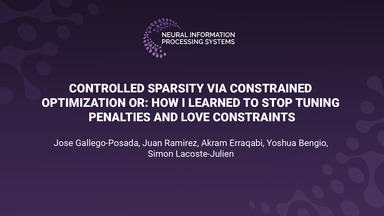Distributional deep Q-learning with CVaR regression
Dec 2, 2022
Speakers
About
Reinforcement learning (RL) allows an agent interacting sequentially with an environment to maximize its long-term return, in expectation. In distributional RL (DRL), the agent is also interested in the probability distribution of the return, not just its expected value. This so-called distributional perspective of RL has led to new algorithms with improved empirical performance. In this paper, we recall the atomic DRL (ADRL) framework based on atomic distributions projected via the Wasserstein-2 metric. Then, we derive two new deep ADRL algorithms, namely SAD-Q-learning and MAD-Q-learning (both for the control task). Numerical experiments on various environments compare our approach against existing deep (distributional) RL methods.Reinforcement learning (RL) allows an agent interacting sequentially with an environment to maximize its long-term return, in expectation. In distributional RL (DRL), the agent is also interested in the probability distribution of the return, not just its expected value. This so-called distributional perspective of RL has led to new algorithms with improved empirical performance. In this paper, we recall the atomic DRL (ADRL) framework based on atomic distributions projected via the Wasserstein-…
Organizer
NeurIPS 2022
Účet · 962 sledujících
Like the format? Trust SlidesLive to capture your next event!
Professional recording and live streaming, delivered globally.
Sharing
Recommended Videos
Presentations on similar topic, category or speaker
Towards Human-Level Bimanual Dexterous Manipulation with Reinforcement Learning
Zhlédnout později
Yuanpei Chen, …
Pro uložení prezentace do věčného trezoru hlasovalo 0 diváků, což je 0.0 %
LOT: Layer-wise Orthogonal Training on Improving l2 Certified Robustness
Zhlédnout později
Xiaojun Xu, …
Pro uložení prezentace do věčného trezoru hlasovalo 0 diváků, což je 0.0 %
Memorization and Optimization in Deep Neural Networks with Minimum Over-parameterization
Zhlédnout později
Pro uložení prezentace do věčného trezoru hlasovalo 0 diváků, což je 0.0 %
Polynomial time guarantees for the Burer-Monteiro method
Zhlédnout později
Pro uložení prezentace do věčného trezoru hlasovalo 0 diváků, což je 0.0 %
Adversarial training for high-stakes reliability
Zhlédnout později
Pro uložení prezentace do věčného trezoru hlasovalo 0 diváků, což je 0.0 %
Controlled Sparsity via Constrained Optimization or: How I Learned to Stop Tuning Penalties and Love Constraints
Zhlédnout později
Pro uložení prezentace do věčného trezoru hlasovalo 0 diváků, což je 0.0 %





